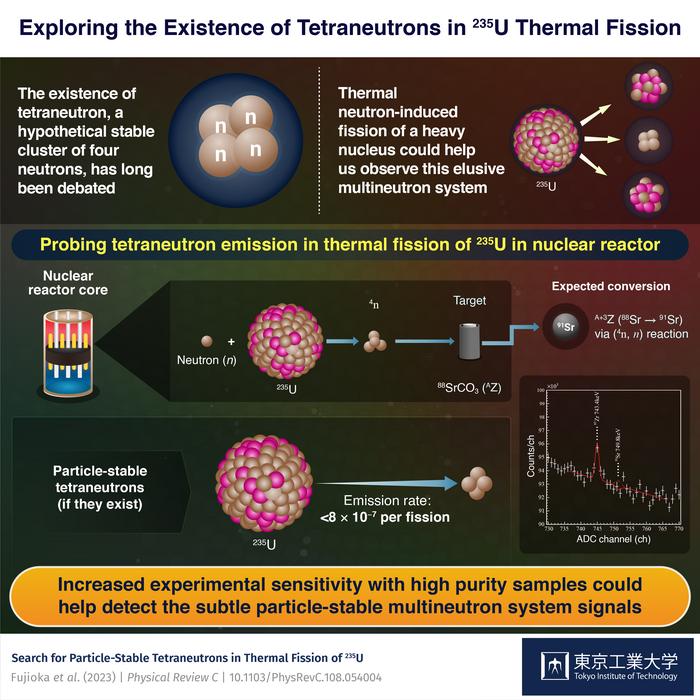Tetraneutron is an elusive atomic nucleus consisting of four neutrons, whose existence has been highly debated by scientists. This stems primarily from our lack of knowledge about systems consisting of only neutrons, since most atomic nuclei are usually made of a combination of protons and neutrons. Scientists believe that the experimental observation of a tetraneutron could be the key to exploring new properties of atomic nuclei and answering the age-old question: Can a charge-neutral multineutron system ever exist?

Credit: Tokyo Tech
Tetraneutron is an elusive atomic nucleus consisting of four neutrons, whose existence has been highly debated by scientists. This stems primarily from our lack of knowledge about systems consisting of only neutrons, since most atomic nuclei are usually made of a combination of protons and neutrons. Scientists believe that the experimental observation of a tetraneutron could be the key to exploring new properties of atomic nuclei and answering the age-old question: Can a charge-neutral multineutron system ever exist?
Two recent experimental studies reported the presence of tetraneutrons in bound state and resonant state (a state that decays with time but lives long enough to be detected experimentally). However, theoretical studies indicate that tetraneutrons will not exist in a bound state if the interactions between neutrons are governed by our common understanding of two or three-body nuclear forces.
Intrigued, a team of researchers led by Associate Professor Hiroyuki Fujioka from Tokyo Institute of Technology set out to investigate the feasibility of bound tetraneutron emission. In their recent study published in Physical Review C, the team explored the possible emission rate of particle-stable tetraneutron via thermal neutron-induced fission of 235U (Uranium-235) in a nuclear reactor. “We are aware from previous literature that the dominant thermal fission process for 235U is binary fission, which leads to the emission of two heavy nuclear fragments together with 2.4 neutrons, on average. But there is a 0.2% probability of ternary fission, in which light nuclear fragments are emitted. We, therefore, chose this route for our experiment under the assumption that the hypothetically bound tetraneutron could be a ternary particle in uranium fission,” explains Dr. Fujioka.
The team adopted the well-known instrumental neutron activation analysis method, where a trace element in a chosen sample is irradiated and activated by the capture of thermal neutrons. For this study, 88SrCO3 was chosen as the target sample and was irradiated for two hours at a thermal power of 5 MW in a nuclear research reactor. The team also performed γ-ray spectroscopy for the irradiated sample to detect signals corresponding to a possible tetraneutron emission.
The 88Sr nuclei were expected to convert into 91Sr with a Q value (change in mass between the initial and final states of a reaction expressed in terms of energy units) of 20 MeV minus the binding energy of the tetraneutron. Since 91Sr is unstable, its radioactive decay followed by the release of γ-rays would indicate the emission of particle-stable tetraneutrons.
The γ-ray spectroscopy results for the irradiated 88Sr sample, however, did not show any photopeak corresponding to the formation of 91Sr. Based on this, the team estimated that if particle-stable tetraneutrons exist, their emission rate might be lower than 8 × 10−7 per fission at the 95% confidence level. They also suggested that improving the purity of samples and increasing the sensitivity of experimentation could help with the detection of subtle signals arising from tetraneutrons.
Dr. Fujioka says, “Our study showed that the instrumental neutron activation method in radiochemistry can be applied to address the open question in nuclear physics. We will improve the sensitivity further to seek for the elusive, charge-neutral system.”
While the team was not able to detect bound tetraneutrons, their work has laid a solid framework for future studies on the elusive tetraneutrons and other such systems.
Journal
Physical Review C
DOI
10.1103/PhysRevC.108.054004
Method of Research
Experimental study
Subject of Research
Not applicable
Article Title
Search for particle-stable tetraneutrons in thermal fission of 235U
Article Publication Date
22-Nov-2023




